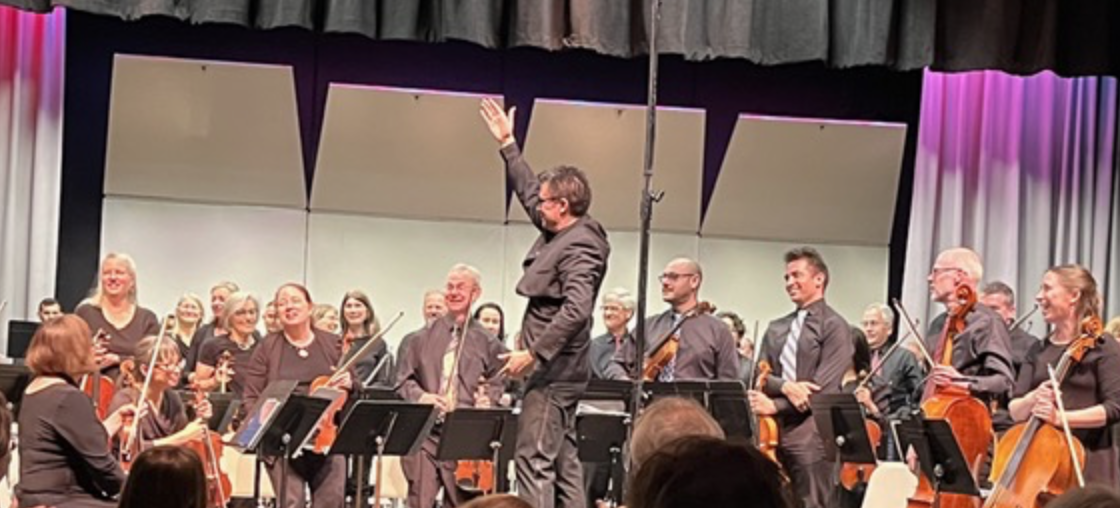|
Symphony
MAHLERTHON AT SRS WEILL HALL CONCERT
by Peter Lert
Sunday, December 8, 2024
Symphony
FRANKENSTEIN THRILLS IN UNIQUE SO CO PHIL CONCERT IN JACKSON THEATER
by Peter Lert
Saturday, October 26, 2024
Symphony
MOZART THE SUBLIME IN UKIAH SYMPHONY'S CONCERT
by Terry McNeill
Sunday, September 22, 2024
Symphony
POTENT TCHAIKOVSKY INTERPRETATION IN PHILHARMONIC'S 25TH ANNIVERSARY OPENER
by Terry McNeill
Saturday, September 21, 2024
Symphony
THE SRS ON THE ROAD TO 100
by Terry McNeill
Sunday, June 9, 2024
Symphony
TAO'S GERSHWIN AT SRS CONCERT IN WEILL HALL
by Peter Lert
Monday, May 13, 2024
Symphony
FATEFUL TRIUMPH IN COM'S TCHAIKOVSKY FIFTH
by Terry McNeill
Sunday, May 12, 2024
Symphony
MONUMENTAL MAHLER 5TH IN SO CO PHIL'S SEASON ENDING CONCERT
by Terry McNeill
Sunday, April 14, 2024
Symphony
YOUTH ORCHESTRA CHARMS BIG SPRING LAKE AUDIENCE
by Terry McNeill
Wednesday, February 28, 2024
Symphony
SOLO BRILLIANCE IN SANTA ROSA SYMPHONY CONCERT
by Terry McNeill
Saturday, February 17, 2024
|
 |
 Norman Gamboa and his Orchestra April 14 |
MONUMENTAL MAHLER 5TH IN SO CO PHIL'S SEASON ENDING CONCERT
by Terry McNeill
Sunday, April 14, 2024
Each season the Sonoma County Philharmonic does a stretch, meaning they take on one composition that makes inordinate demands on their nonprofessional orchestra. That happened in the two concert April set in the Jackson Theater when Conductor Norman Gamboa programed Mahler’s monumental Fifth Symphony. The April 14 season ending concert is reviewed here.
First heard in 1904, the Mahler Fifth is a big mountain to climb, and the music from Tom Hyde’s opening trumpet summons call to the ending just over an hour later has a whiplash character – periods of shrieks and menacing violence, a funeral march and potent sound contrasting with warm lyricism and the famous Adagietto movement that envelopes sadness and grief.
Every instrumental section in the first movement had a place in the sun – cellos “weeping,” bassoons, clarinets and surprisingly violas stating themes, with Mr. Gamboa busy keeping everything in harness, the tempo mostly slow with jumps to speed. The interpretation captured the fantastical nature of Mahler’s convoluted score. Especially pungent were the Philharmonic’s horn section that highlighted the march’s languorous character, along with Floyd Reinhart’s tuba, piccolo and raucous timpani/percussion playing.
In the Scherzo horns set things in motion, with a single horn call obligato (Rachel Aragaki) that was difficult to perform but indeed satisfying. The music’s ebullience alternated with seeming nostalgia. There were more unique sounds (triangle) and lovely trio from the principal violin, cello and viola, with Robby Morales beguilingly holding the final extended note. So many contrasts, so many instrumental paths.
Strings and harp (Christina Goodwin) were featured in the eminent Adagietto, a short ten minute threnody of gloomy beauty deftly controlled by the conductor. The impact of just a few strands of sound was palpable.
The Orchestra’s brass section came back to prominence in the concluding Rondo, a long set of rising sonic expectations for the trumpets and trombones, with solos for Mr. Morales and Pam Otsuka. Mr. Gamboa fashioned a reading that was both heraldic and triumphal, no easy feat to manage with the large forces and demanding parts, each jockeying to be heard at volume. The ending was played not with exaltation but with a shout of symphonic laughter. Laughter in Mahler?
The audience of 250 erupted with an ovation, with Mr. Gamboa recognizing excellence in several groups: horns, brass and Joseph Lang’s percussion players in the forefront.
Mahler was quoted that a great symphony must encompass the whole world, and the So Co Phil’s performance opened sonic vistas that are likely to remain in the listener’s consciousness for a long time. Great music enters the ear with ease and leaves the mind with difficulty.
The concert opened with a short Michael Haydn Symphony, No. 25 in G Major, that passed without much notice though the second movement sounded diluted Mozart and the third movement disclosed in fast passages for the violins ersatz Franz Joseph Haydn writing. It warmed up the players for the Mahler odyssey to come.
Concluding the season was a lavish post-concert reception in the Hall’s library, a recognition by Board President Steven Peterson and his colleagues of the strong community support the Philharmonic enjoys.
|

